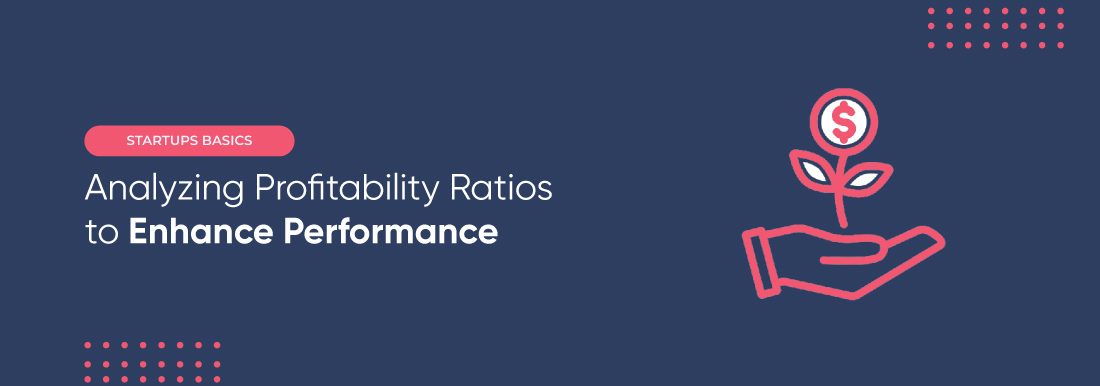Analyzing Profitability Ratios to Enhance Performance
Aug 01, 2023 | 7 Min Read


Jump to Sections
Stay updated
with our Blogs
We will keep you updated about our latest blogs
Share This Blog
The understanding and in-depth analysis of profitability ratios is crucial for enhancing performance, increasing competitiveness, and driving growth for startups. In this blog, we will discuss the significance of profitability ratios and how they can be leveraged in making informed decisions.
Understanding profitability ratios
Profitability ratios are financial metrics that measure the profit-generating ability of the business from its assets and operations. The following factors explain the importance of profitability ratios to businesses:
Profitability ratios are financial metrics that measure the profit-generating ability of the business from its assets and operations. The following factors explain the importance of profitability ratios to businesses:
Performance Evaluation: Businesses can compare their profitability ratios over time or with the industry average. By comparing profitability ratios across different time periods, managers can identify trends, evaluate their progress, and determine whether they are achieving their financial goals.
Comparing industry averages provide valuable insights to a business and can help them identify areas they are underperforming or overperforming, as well as take corrective measures, accordingly.
Operational Efficiency: Profitability ratios shed light on the efficiency of the business’s operations as well as its cost management capabilities. For instance, the gross profit margin indicates the effectiveness of the production and pricing strategies while the net profit margin indicates the efficiency of cost management strategies adopted by the business.
Access to Financing: Profitability ratios are crucial indicators used by investors and stakeholders to assess a business’s financial performance and return on investment. A consistently strong financial performance enhances the creditworthiness of the business, attracting investors and increasing opportunities to secure loans.
Key profitability Ratios
The following are some of the key profitability ratios essential for all businesses to calculate:
- Gross Profit Margin:
Gross Profit Margin ratio = Gross profit / Net sales
This ratio measures the revenue remaining after deducting the cost of goods sold as a percentage of sales. A higher ratio is preferred over lower ratios, like other profitability ratios. The ratio can be increased by changing the pricing strategy or purchasing costs of the business. By selling at a higher price with a less than proportionate fall in volumes, or purchasing raw materials at a lower price, businesses can enhance their gross profit margin.
- Net Profit Margin:
Net Profit Margin = Net Income / Net Sales
The net profit margin is a measure of the revenue remaining after deducting all expenses as a percentage of sales. It determines the effectiveness of cost control measures implemented by the company.
- Return on Assets:
Return on Assets = Net Income / Total Assets
This measures the assets’ capability in generating returns for the business. A higher ratio indicates more efficiency in the usage of assets.
- Return on Equity:
Return on Equity = Net Income / Shareholders Equity
This ratio measures the return generated in relation to the equity invested by shareholders. Investors often prefer businesses with a higher Return on Equity.
Want to learn about the next steps for growing your business ?
Implementing Effective Profitability Ratio Analysis
Implementing effective profitability ratio analysis is essential for startups to optimize their financial performance and drive sustainable growth and profitability.
The following steps should be considered:
Identifying the ratios most suitable for your business: Managers should determine which profitability ratios are most suited to their industry. Once determined, managers should measure each ratio on a periodic basis and compare them with business goals, industry benchmarks, or past performance to gain valuable insights.
Collecting Accurate Data: Businesses should ensure that all data is relevant, up-to-date, and accurate before performing ratio analysis. By adopting accounting software and automation, managers can have accurate accounting data at their fingertips at all times.
Managers should ensure consistency in the calculations for meaningful comparisons and interpretations of the data. Financial reporting services like Accountimize can automate the calculations, eliminating manual errors and providing in-depth analysis of the data.
Perform Trend Analysis: Managers should analyze the business performance over several periods to identify factors for significant fluctuations and determine the reasons for such variations. Businesses should also identify areas for improvement or competitive advantage. For example, a low gross profit margin should be tackled by identifying methods to increase sales or reduce production/purchasing costs.
Develop Action Plans: Businesses should set goals and develop strategies to address areas for improvement. Targets should be communicated, and responsibilities assigned to the relevant staff, while monitoring systems should be established to regularly review progress, or to adjust the strategy in meeting the required objectives. Leveraging accounting technology such as financial reporting tools, accounting software, and dashboarding can enable real-time tracking, allowing proactive decision-making and timely adjustments to optimize financial performance.
Seeking Professional Assistance: Working with Accountimize
Accountimize is a team of talented CPAs providing a comprehensive range of essential services such as bookkeeping, ratio analysis, and financial reporting services for small businesses. We are certified advisors of the top accounting software, ensuring all your data is accurate and up-to-date, available in real-time at your fingertips. With our vast clientele, we can provide you with valuable insights, industry benchmarks, and best practices that can further enhance your analysis and decision-making process.
Contact us for further information on how we can help you excel at your business.
Book a Discovery call


Stay updated
with our Blogs
We will keep you updated about our latest blogs



